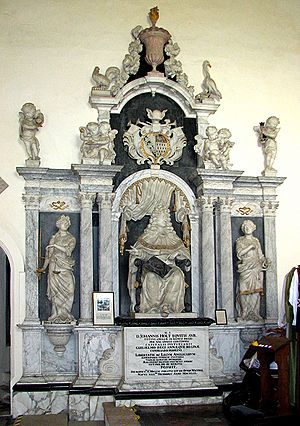John Holt (Lord Chief Justice) facts for kids
Quick facts for kids
Sir John Holt
|
|
|---|---|

Portrait by Richard van Bleeck, c. 1700
|
|
| Born | 23 December 1642 |
| Died | 5 March 1710 (aged 67) |
Sir John Holt (born December 23, 1642 – died March 5, 1710) was an important English lawyer and judge. He became the Lord Chief Justice of England, a very high legal position, on April 17, 1689, and served until he died. He is often remembered for helping to stop the trials and punishments of people accused of being witches in English law.
Early Life and Education
Sir John Holt was born in a town called Abingdon in Berkshire (which is now part of Oxfordshire). His father, Sir Thomas Holt, was also a lawyer and a Member of Parliament (MP) for Abingdon.
Young John Holt went to John Roysse's Free School in Abingdon (now known as Abingdon School) from 1652 to 1658. After that, he studied at Oriel College, Oxford and Gray's Inn, which is a place where lawyers are trained. He was known for being quite wild in his younger days, but he later became very dedicated to studying law. In 1663, he officially became a lawyer, which is called being "called to the bar".
A Career in Law
John Holt believed strongly in people's rights and freedoms. He became well-known for how he defended people in important court cases, especially those involving the government.
In 1675, he married Ann Cropley, but they did not have any children.
From 1685 to 1686, Holt served as the recorder of London, a judge who oversaw the city's courts. Around the same time, he was made a "king's serjeant" and received the title of knighthood. However, he was removed from his recorder role because he disagreed with the king's power to use military law during peacetime. Even so, he remained a king's serjeant, which stopped him from defending people accused by the king.
Holt played a key role in the Glorious Revolution that brought William III to the throne. After William became king, Holt was appointed Lord Chief Justice of the King's Bench. This meant he was the head judge of one of England's most important courts. He was famous for protecting the court's powers, even when they clashed with the Houses of Parliament. Although he generally supported the Whig party, he always made sure to be fair and unbiased as a judge.
In 1700, he was offered the job of Lord Chancellor, which is the highest legal position in England, but he turned it down.
Sir John Holt passed away in London on March 5, 1710. He was buried in Redgrave church in Suffolk, where a beautiful monument was built in his honor.
Ending Witchcraft Trials
Sir John Holt is highly praised for his role in stopping the trials of people accused of witchcraft in England. Even before a law was passed in 1735 to officially end these trials, judges like Holt had largely stopped finding people guilty of witchcraft.
Historian John Callow says that Holt was very brave to do this. He faced pressure from religious groups, angry crowds, and many people who still believed in witchcraft. Despite this, Holt used his position to ensure fair trials and prevent wrongful convictions, helping to bring an end to a dark period in English legal history.
Images for kids




